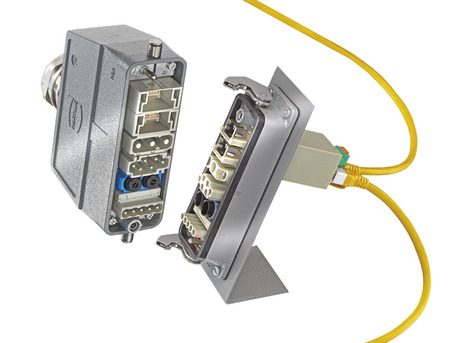
ELGIN, IL,– In launching the first Han-Smart® modules, HARTING is bringing new, intelligent capabilities to the highly esteemed, customer configurable Han-Modular® connector system. Until now, industrial connectors have been used exclusively as passive devices for carrying power, signal, data transmission and pneumatics – functions they continue to provide. However, with Han-Smart® solutions, connectors can provide added value while beginning to evolve into active devices to serve the needs of future manufacturing. These three modules are just the beginning:
More details from Harting (www.harting-usa.com):
Han-Modular® Mini-Switch US4 module is a 4 port unmanaged Ethernet Mini-Switch that supports RJ-45 terminated high speed Ethernet devices. An advanced Ethernet and network switch in one, it facilitates the integration of additional Ethernet nodes to make expansion or retrofitting easier than ever. For example, high-resolution cameras used for quality assurance or infrared temperature sensors can be incorporated into a network at a point closer to the field – wherever there is a Han-Modular® connector installed. The module supports 10/100/1000 Mbits/s. It’s Plug&Play compatible, with surge protection, and integrated LEDs that provide quick power and network diagnostics.
Han-Modular® Surge Protection module puts transient overvoltage protection for analog and digital devices in the connector that would otherwise require separate, external protective solutions. This simplifies wiring arrangements, saving on space and labour cost. It protects up to two pairs of balanced signals interfaces with electrical isolation against normative 8/20μs current pulses. The preferred field of application for this module is for protecting low voltage signal interfaces (24VDC) or machinery using 0/4-20mA current. The surge energy (5kv Surge per line) is discharged via the earthed hinged frame of the Han-Modular® system.
Han-Modular® CAN ID Module has 10MB of memory storage for retaining the revision status of drives and their parameters and other technical information. This helps ensure reliable operations, minimizes downtime during setup or maintenance and can even form part of a predictive maintenance program. During servicing, drive configuration data stored in the module is easily accessed so individual machine elements can be swapped out or repaired faster. There is no need to search for hardcopies or electronic files on a server. Maintenance history per location is easily retrievable, even years later. There is no data loss in the event of a device exchange, and a correct connection is virtually assured with verification using the stored machine data. Markets well-suited for this module include wind energy, industrial building automation, machinery and robotics.


